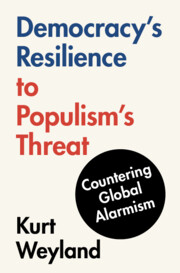Book contents
- Democracy’s Resilience to Populism’s Threat
- Democracy’s Resilience to Populism’s Threat
- Copyright page
- Contents
- Tables
- Acknowledgments
- 1 The Populist Threat to Democracy
- 2 How Institutional Constraints and Conjunctural Opportunities Condition Populism’s Threat to Democracy
- 3 Neoliberal and Right-Wing Populism in Latin America
- 4 “Bolivarian” and Left-Wing Populism in Latin America
- 5 Right-Wing and Traditionalist Populism in Europe
- 6 Right-Wing Populism in the USA
- 7 Conclusion
- References
- Index
5 - Right-Wing and Traditionalist Populism in Europe
Published online by Cambridge University Press: 11 January 2024
- Democracy’s Resilience to Populism’s Threat
- Democracy’s Resilience to Populism’s Threat
- Copyright page
- Contents
- Tables
- Acknowledgments
- 1 The Populist Threat to Democracy
- 2 How Institutional Constraints and Conjunctural Opportunities Condition Populism’s Threat to Democracy
- 3 Neoliberal and Right-Wing Populism in Latin America
- 4 “Bolivarian” and Left-Wing Populism in Latin America
- 5 Right-Wing and Traditionalist Populism in Europe
- 6 Right-Wing Populism in the USA
- 7 Conclusion
- References
- Index
Summary
This chapter documents the restrictive conditions under which rightwing, traditionalist populism managed to destroy democracy in Europe. Only Victor Orban of Hungary (2010-present) and Recep Erdogan of Turkey (2003-present) have accomplished this feat because they benefited from the institutional openness of parliamentary systems and faced an acute, severe crisis in the economy. This massive problem discredited the established parties, so the two populist leaders won clear parliamentary majorities, succeeded in dismantling the remaining checks and balances, and established authoritarianism. In the absence of a crisis and a reliable parliamentary majority, by contrast, Polish populists have tried to push aside institutional constraints through para-legal maneuvers, but have provoked substantial domestic and international pushback, which has defended democracy. Moreover, several populists in Bulgaria, the Czech Republic, Romania, Slovakia, and Slovenia, who did not encounter conjunctural, resolvable economic crises, did not manage to still their power hunger and asphyxiate democracy. Facing similar conditions, Silvio Berlusconi in Italy (1994, 2001–2006, 2008–2011) left democracy intact as well.
Keywords
- Type
- Chapter
- Information
- Democracy's Resilience to Populism's ThreatCountering Global Alarmism, pp. 159 - 195Publisher: Cambridge University PressPrint publication year: 2024

